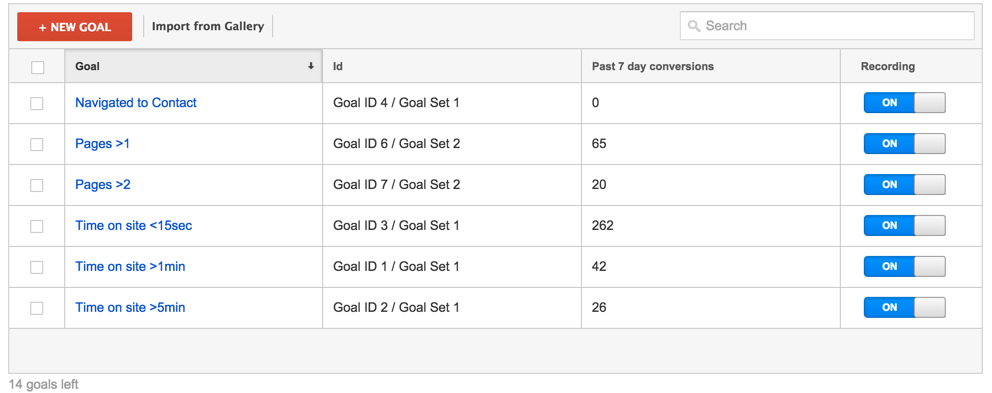Figure out What Data Is Google Analytics Goals Unable to Track
Figure out What Data Is Google Analytics Goals Unable to Track
Blog Article
Discover the Limitations of Google Analytics Goals: Revealing the Data Types That Remain Untrackable
As organizations increasingly depend on data-driven decision-making, understanding the limitations of tools like Google Analytics comes to be paramount. While Google Analytics Goals deal useful insights right into customer interactions, there exist information kinds that avoid tracking, posturing difficulties to a thorough understanding of individual actions. These untrackable information types question regarding the precision and completeness of the analytics information that organizations heavily trust for their electronic approaches. Curious to reveal the concealed unseen areas in your data analysis process?
Incomplete User Journey Tracking
Incomplete user trip tracking within Google Analytics can prevent the ability to accurately assess user actions. When the user trip is not totally tracked, there are spaces in the data that protect against a detailed understanding of exactly how users communicate with a web site. This absence of insight can cause missed possibilities for optimization and enhancements to the individual experience.
One common problem with incomplete individual journey tracking is the lack of ability to see the full course that users take in the past finishing a goal or leaving the website. Without this info, it is testing to recognize where users might be running into barriers or rubbing points that stop them from transforming. Furthermore, incomplete tracking can cover the effect of particular marketing initiatives or site modifications on user actions.
To address this constraint, it is essential to establish proper tracking mechanisms within Google Analytics to record the whole individual journey. This might entail establishing occasion tracking, goal funnels, or using devices like Google Tag Manager to make sure that no vital interactions go unrecorded. By gaining an extensive view of the user journey, site owners can make more educated choices to boost customer involvement and drive conversions.
Attribution Difficulties
Browsing through attribution challenges in Google Analytics needs a complete understanding of how various touchpoints contribute to the overall conversion procedure. Acknowledgment difficulties occur from the intricacy of modern-day consumer journeys, where users communicate with numerous networks before transforming. Google Analytics supplies numerous attribution designs like very first touch, last touch, and direct, each using a various point of view on exactly how credit score is designated to touchpoints along the conversion course. Nevertheless, these designs might not constantly properly mirror the real influence of each touchpoint on the conversion.
One usual acknowledgment challenge is the trouble in attributing conversions to the appropriate source, especially in cases where individuals interact with several networks before converting. This can result in inaccuracies in determining which advertising efforts are driving one of the most conversions. Additionally, cross-device tracking positions one more acknowledgment challenge, as individuals often switch over in between devices during their journey, making it testing to track their communications flawlessly. Marketers should very carefully translate and analyze attribution information to make educated decisions and maximize their advertising strategies effectively.
Offline Conversions
Given the difficulties connected with associating conversions accurately in online networks, the dimension of offline conversions offers a substantial possibility for marketers looking for a more thorough understanding of their consumers' journey. Offline conversions describe actions that customers absorb the physical globe, such as making purchases in brick-and-mortar stores or over the phone, participating in events, or engaging with published materials - what data important site is google analytics goals unable to track. These conversions are critical for organizations that run both online and offline, as they supply useful insights right into the effectiveness of marketing projects across numerous touchpoints
Tracking offline conversions typically presented a substantial challenge for marketing professionals, as it was challenging to connect these actions back to details on the internet interactions precisely. With advancements in modern technology, such as the integration of CRM systems, unique identifiers, and promo code codes, organizations can currently bridge the gap between online and offline information to obtain a more holistic view of consumer habits. By properly gauging offline conversions, marketing professionals can enhance their approaches, allot resources much more efficiently, and inevitably enhance the total customer experience.
Cross-Device Monitoring
Cross-device monitoring plays a crucial function in comprehending the interconnected nature of customers' electronic interactions throughout numerous tools. In today's omnichannel world, where individuals effortlessly switch over between desktops, smartphones, and tablet computers, tracking their actions throughout these devices is necessary for marketers to gain a thorough view of their client journey.

In addition, personal privacy problems and regulations such as GDPR and CCPA have better complicated cross-device tracking. With individuals demanding more control over their data and enhanced limitations on monitoring innovations, online marketers have to discover privacy-compliant and ingenious means to link individual interactions across tools.
Dynamic Material Involvement
Recognizing user involvement with dynamic content is crucial in maximizing electronic marketing strategies for enhanced audience interaction. Dynamic web content refers to site elements that alter based on user actions, choices, or other aspects, supplying a personalized experience. Nonetheless, tracking individual interactions with vibrant material presents obstacles for typical analytics devices like Google Analytics.
While Google Analytics can track basic communications like clicks and page sights, it may struggle to catch even more nuanced involvements within vibrant material. what data is google analytics goals unable to track. Metrics such as time invested in particular dynamic aspects, float activities, or interactions within pop-ups are my site often not conveniently measurable making use of typical tracking approaches. This constraint prevents marketing professionals' ability to fully realize how individuals are engaging with dynamic material and customize their strategies accordingly

Final Thought
In verdict, Google Analytics objectives have constraints in tracking insufficient customer trips, connecting conversions properly, recording offline conversions, tracking cross-device communications, and measuring dynamic content involvement. These restrictions highlight the importance of exploring additional monitoring techniques and tools to obtain an extra detailed understanding of user actions and conversions past what Google Analytics can provide.
While Google Analytics Goals offer beneficial insights into user interactions, there exist data kinds that elude monitoring, posing challenges to a comprehensive understanding of user behavior.Insufficient user journey monitoring within Google Analytics can prevent the capacity to properly examine individual actions. When the user trip is not totally tracked, there are voids in the information that protect against an extensive understanding of exactly how customers connect with an internet site.One common problem with incomplete user journey monitoring is the inability to see the complete course that customers take previously finishing an objective or leaving the site. By acquiring an extensive view of the user journey, site proprietors can make more educated decisions to improve customer engagement and drive conversions.
Report this page